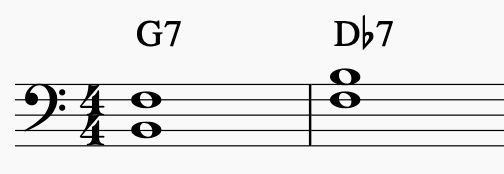The Pippinpotato Corner All things pippin and potato
Tritone Substitution
3 minute read

Tritone substitution is an easy way to reharmonize a 2-5-1 progression. It’s also easy to pepper them throughout your playing outside of 2-5-1 progressions. They give a nice amount of clash to spice up your playing.
The Basics
Let’s look at the 2-5-1 progression Dm7 - G7 - CMaj7

Here is what it looks like after a tritone substitution:

As you can see, what we’ve changed is we’ve changed the G7 to a Db7. Now instead of the root going from the D down a fifth to the G and down another fifth to the C, we have the root going from D down a half step to Db and down another half step to C.
That’s really all there is to it; it’s very simple. When you see a 2-5-1 progression, you just change the 5 to a b2 and you’re done.
In Practice
Let’s look at an example from “Danny Boy.”

We see that there’s a 2-5-1 progression in the key of Ab major in the 3rd and 4th measures, so we can apply a tritone substitution here. All we need to do is change the 5 (Eb7) to the note between 2 and 1 (A7).

Notice how it sounds a bit more dissonant and less vanilla. You also get the root movement of half steps instead of fifths. It’s good to put these into your playing and change up your 2-5-1s. The 2-5-1 progression is a very common sound in jazz songs, so if you want your playing to sound less homogenous, you should reharmonize some of the 2-5-1s into tritone substitutions.
The Theory
The reason tritone substitutions work is that the tritone interval in the dominant chord stays the same. Let’s go back to the Dm7 - G7 - CMaj7 progression.
Every dominant chord has a tritone interval in it. This is what gives the dominant chord its characteristic dissonant sound. The tritone interval is in the shell (the 3rd and 7th degrees).
What we notice for G7 and Db7 is that they have the same tritone interval. This is why the substitution works.

The root movement of a fifth is a significant part of the sound of the 5-1 progression, but an equally significant part is the resolution of the tritone interval. When you only pay attention to the shell of the chords (3 and 7), in the G7-CMaj7 progression, from the perspective of the G7 chord, the 3 (B) does not move, while the 7 (F) resolves downwards a half step. This 7 resolving downwards is the resolution of the tritone interval and is a characteristic sound of the 5-1 progression.
This characteristic sound is maintained with the tritone substitution. Play the two progressions below, and pay attention to the B and F resolving to B and E in both cases.

Something interesting is that to find the sister dominant seventh with the same tritone interval, you move the root up or down (it’s the same) a tritone interval; Db is a tritone away from G.
Other Uses
Since you’re substituting the 5, you can use this in any 5-1 progression.
In “Danny Boy,” the first two chords form a 5-1 progression, so we can perform a tritone substitution on the 5 chord.

You can also use it as a reharmonization in any situation. If you add a dominant 7 a half step above a chord, you’re performing a tritone substitution on it. Here we’re adding a B7 before the Bb-7 in measure 3.

Final Note
The tritone substitution is a very simple reharmonization tool to add to your repertoire, so you should use it.
Written on July 21st , 2020 by Chris Cheung